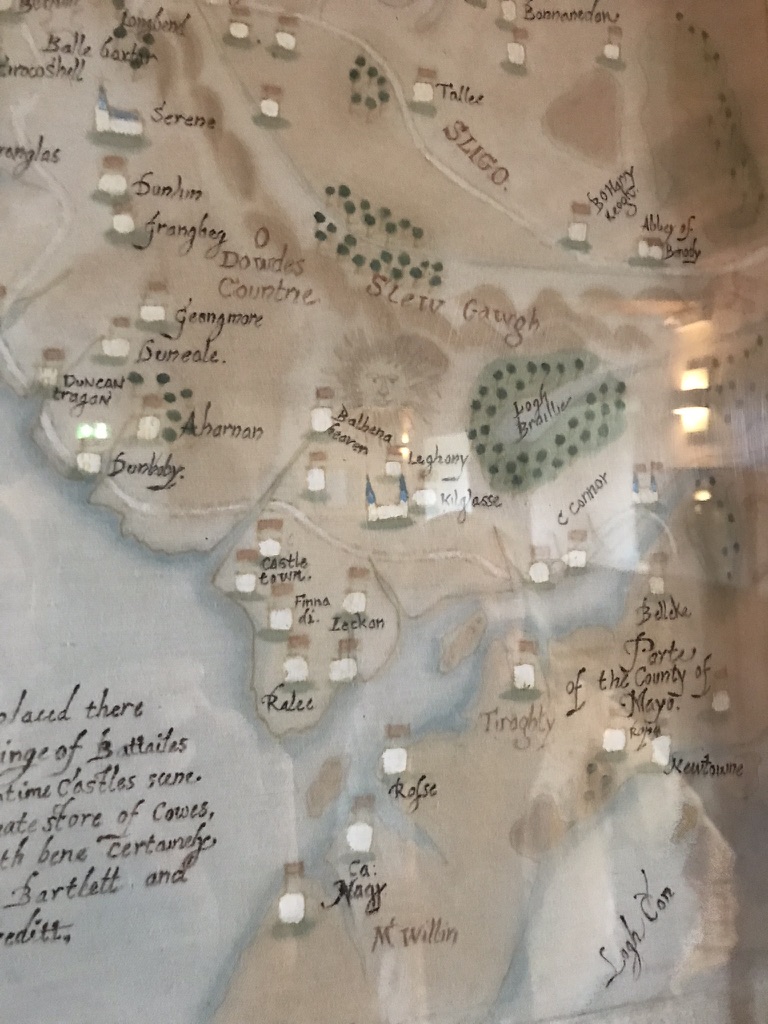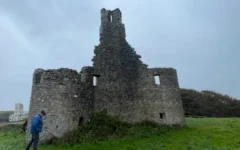Unearthing the O’Dowd Legacy: The Enduring Mystery of the “Twenty Castles”
July 9, 2025 2025-09-27 23:20Unearthing the O’Dowd Legacy: The Enduring Mystery of the “Twenty Castles”
For centuries, the O’Dowd (Ó Dubhda) clan reigned supreme in Uí Fiachrach Muaidhe, a powerful kingdom stretching across what is now County Mayo and County Sligo in Northwest Connacht. Their saga is one of fierce independence and strategic prowess, famously encapsulated in the legend of their kingdom being “ringed with 20 castles.” But what exactly were these formidable strongholds, and why were they so crucial to the O’Dowds’ enduring power?
The “Twenty Castles”: A Network of Resilience
The notion of “twenty castles” isn’t merely a poetic flourish; it speaks to a sophisticated and extensive defensive strategy. While finding a definitive list of precisely twenty O’Dowd-built or owned castles proves to be an intriguing historical puzzle, the evidence strongly points to a dynamic network of fortifications that secured their dominance. These weren’t always grand, sprawling fortresses, but rather strategic strongholds designed for resilience and control.
Many of these were what historians refer to as “10-Pound Castles.” This evocative term hints at their typical size and a specific historical context. Though the original £10 subsidy from Henry IV in 1429 was primarily for castle building in the English Pale (around Dublin), Gaelic chieftains like the O’Dowds swiftly adopted and adapted this highly effective architectural style.
Why Were These Castles Built?
The construction of these castles, particularly the ubiquitous tower house, was driven by fundamental needs in a tumultuous medieval Ireland:
- Assertion of Power: A castle was a visible and undeniable declaration of a chieftain’s authority and status. It solidified their claim to the land and served as a symbol of clan strength.
- Territorial Control: Strategically placed, these castles allowed the O’Dowds to control key passes, river crossings, trade routes, and fertile lands. They served as administrative centers, tax collection points, and garrisons.
- Defense Against Rivals: The O’Dowds faced constant challenges from powerful neighboring clans, as well as the encroaching Anglo-Normans and later, English forces. Their network of castles provided crucial defensive points, allowing them to withstand sieges, launch counter-attacks, and hold their territory “intact against the superior forces of the Burkes and Birminghams.”
- Refuge and Residence: Beyond their military function, these castles served as fortified residences for the chieftain, his family, and key retainers. They offered protection in times of conflict and a secure base for daily life.
How Were They Built? The “10-Pound Castle” Blueprint
The “10-Pound Castle,” or tower house, offered a practical and robust defensive solution:
- Compact Design: Typically rectangular, these were multi-storied stone towers, often around 20 feet by 16 feet at the base and standing at least 40 feet high. Some variations included circular designs.
- Thick Walls and Vaults: Their impressive thickness provided formidable protection against early siege methods. Ground floors were often vaulted, offering fire protection and structural stability.
- Strategic Siting: These castles were not randomly placed. They were meticulously chosen for their tactical advantage—overlooking coastlines, guarding river estuaries, controlling passes, or protecting valuable resources like salmon weirs.
- Built on Ancient Foundations: Intriguingly, many O’Dowd castles, as historical records suggest, were built directly over the sites of even more ancient fortifications, such as Stone Age and Bronze Age ringforts. This practice speaks to the enduring strategic importance of certain locations and the O’Dowds’ pragmatic adaptation of existing defensive heritage.
The “Twenty Castles” Enigma: Unraveling the Network
The consistent historical assertion that the O’Dowds “ringed” their kingdom with 20 castles presents a compelling historical puzzle. This description strongly implies a deliberate and extensive defensive network or chain of strongholds rather than merely 20 isolated, large-scale fortresses of the Norman motte-and-bailey or enclosure castle type. The strategic placement of such a large number of fortifications would enable a layered defense, allowing for rapid communication and coordinated responses against invading forces.
Analysis of Fortification Types
The term “castle” in medieval Ireland was not monolithic; it encompassed a diverse array of fortified structures. The O’Dowd defensive network likely comprised a heterogeneous mix of these types:
- Tower Houses: Many of the identified O’Dowd strongholds, such as Rosslee, Rathlee, and Lecan, are explicitly described as tower houses. These were prevalent across Ireland from the early 15th to the 17th centuries, typically standing four or five stories high. They served as both residences and defensive structures for smaller land-owning lordships, whether Gaelic or Anglo-Norman. These structures often incorporated defensive features such as bawn walls (enclosed courtyards), machicolations (projections for dropping projectiles), and yetts (iron grilles over doorways). The widespread adoption of these “10-Pound Castle” designs by a Gaelic clan like the O’Dowds demonstrates a practical adaptation to evolving military technology and a willingness to integrate effective architectural styles, regardless of their origin.
- Ringforts: The O’Dowd clan’s ancient roots are tied to sites like ‘Rath O’Dubhda’ in County Mayo, a large earthen ring fortification that still exists. Ringforts represent an older form of fortified settlement, utilized by Gaelic ancestors from the Iron Age through the Middle Ages. The continuity of occupation or re-use of these ancient sites for later fortifications underscores a deep, long-term understanding of strategic locations within their territory. This suggests that the “20 castles” count may include such re-purposed or continuously occupied ancestral strongholds.
- Norman Castles within O’Dowd Lands: The Anglo-Norman invasion of Connacht in 1237 led to the construction of castles by new English families in what was traditionally O’Dowd territory, including Ardnarea, Castleconor, Enniscrone, and Sligo. These sites were not always under Norman control; the O’Dowds frequently contested and sometimes captured these fortifications, as seen with Ardnarea Castle in 1371. This dynamic frontier meant that “O’Dowd castles” could also include structures originally built by their adversaries but subsequently taken and maintained by the clan. This indicates a fluid and adaptive military landscape where control of key strongholds was constantly in flux.
The heterogeneous nature of the O’Dowd defensive network, combining purpose-built stone tower houses, potentially adapted or re-fortified Norman structures, and continuously occupied or re-used ringforts, points to a sophisticated understanding of their territory and the evolving nature of medieval warfare. The “ringed” description implies a strategic, interconnected defense, where line-of-sight communication might have been possible between some sites, allowing for rapid warning and coordinated response against invaders. This multi-layered approach demonstrates a flexible and adaptive military strategy, utilizing both traditional Gaelic fortifications and newer Anglo-Norman designs to maintain control over their shifting borders.
Challenges in Identifying All Twenty Specific Sites
Despite the consistent mention of “20 castles” in historical accounts, identifying every single one by name and precise location presents a significant challenge. This discrepancy between the stated number and the limited explicitly named O’Dowd castles points to a substantial data gap, which can be attributed to several factors:
- Nature of Medieval Record-Keeping: Historical records from the medieval period, such as the Annals and the Great Book of Lecan, often prioritized documenting major events, genealogies of prominent figures, and the most significant strongholds. A comprehensive inventory of every minor fortification or defensive structure, particularly those that were less imposing or strategically pivotal, was not typically a priority. This means smaller, less prominent defensive sites may have gone unrecorded in the main historical narratives.
- Varying Durability and Ephemeral Nature of Fortifications: The physical remains of fortifications vary greatly in their longevity. While stone tower houses and castles might leave substantial ruins, many smaller defensive structures, particularly those constructed primarily of timber or earth, would have left limited archaeological traces. Over centuries, many of these structures were destroyed, repurposed, or simply decayed, leading to a loss of both physical and documentary evidence. This makes their identification and precise location exceptionally difficult without dedicated archaeological investigation.
- Destruction and Repurposing of Sites: Periods of conflict, such as the Anglo-Norman incursions and later Cromwellian re-conquest, led to the destruction or confiscation of many castles. Sites might have been razed, their stones reused for other constructions, or their strategic importance diminished, leading to their abandonment and eventual disappearance from the landscape and historical memory. For example, Ardnarea Castle was lost for centuries before its recent re-discovery.
The discrepancy between the historical claim of “20 castles” and the limited number of explicitly named and located O’Dowd castles underscores a significant data gap. This situation necessitates a multi-faceted approach to further research, as traditional textual sources alone are insufficient to fully account for the O’Dowd defensive network. Archaeological surveys and detailed local historical research become paramount in such circumstances, offering the potential to uncover structures not explicitly identified in historical texts.
The Enduring Enigma
While a precise list of twenty named O’Dowd-built castles remains a historical riddle, the spirit of this “ring” endures in the ruins scattered across Mayo and Sligo. Castles like Rosslee, Rathlee, Enniscrone, Castleconor, Carn Amhalghaigh, Ardnarea, and Grangemore stand as tangible reminders of the O’Dowds’ resilience and their strategic genius in defending their kingdom. Each weathered stone whispers tales of a powerful clan that understood the vital role of fortifications in shaping destiny.
The O’Dowds’ “ring of 20 castles” isn’t just a count; it’s a testament to their adaptability, their unwavering commitment to their territory, and the architectural ingenuity that allowed a Gaelic lordship to thrive for centuries in a challenging and contested landscape.



